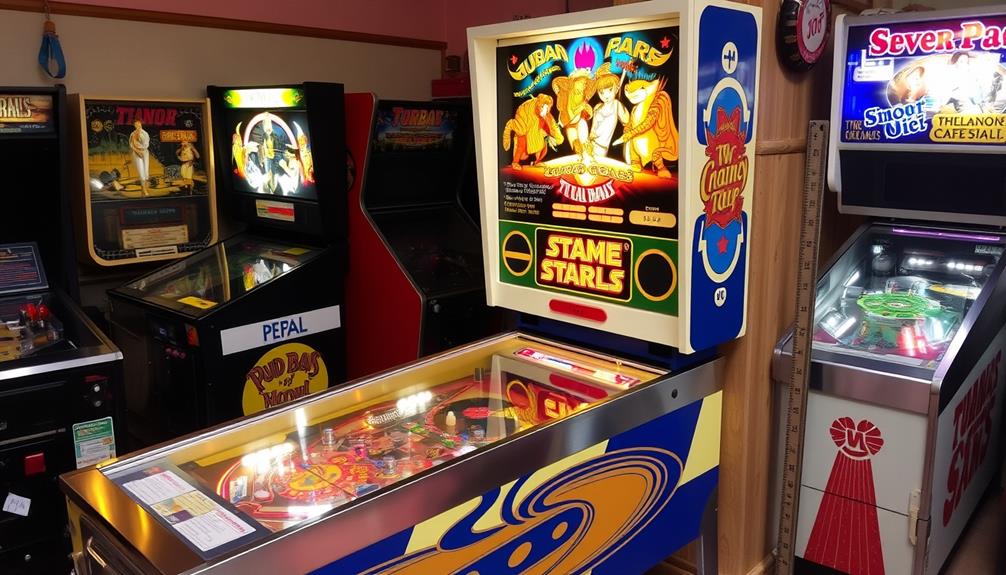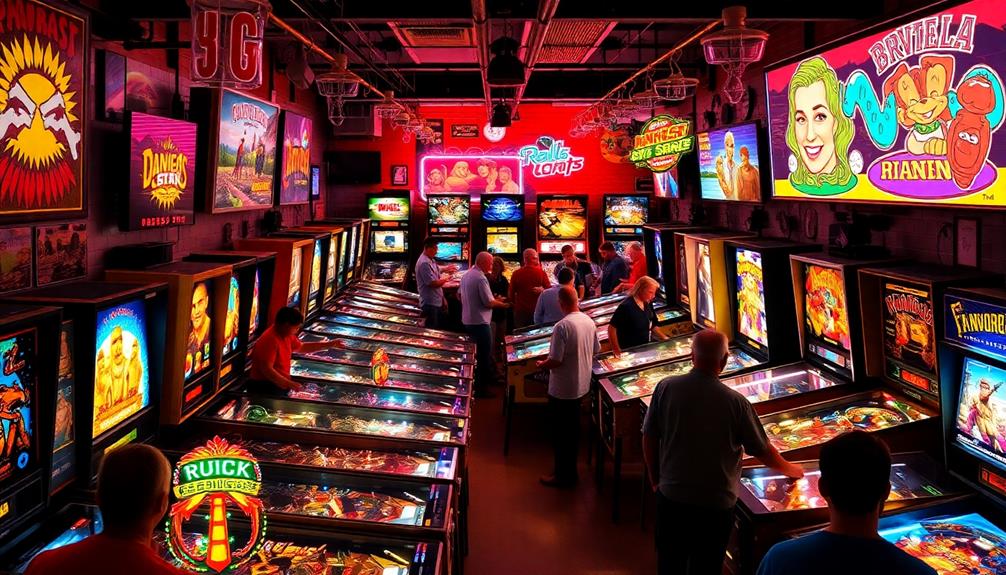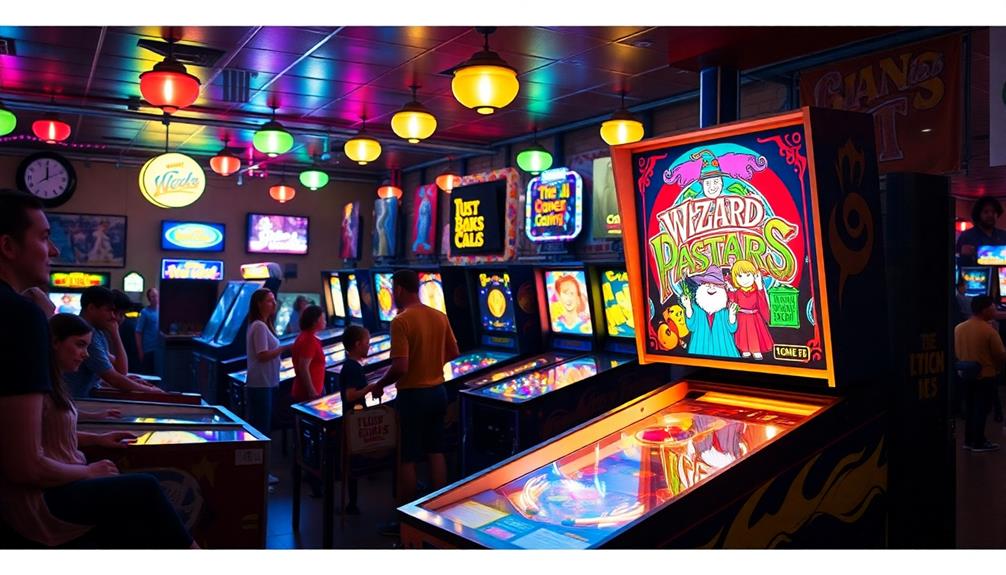Pinball is a thrilling arcade game in which you launch a steel ball onto a sloped playfield filled with targets, bumpers, and flippers. The main objective is to score points by hitting these elements while keeping the ball in play. You use the flippers to guide the ball’s trajectory and trigger scoring mechanisms, emphasizing the importance of timing. The tilt mechanism introduces an additional exciting challenge, as excessive movement can result in penalties. Each machine comes with a distinctive theme, enhancing the enjoyment and strategy of the game. For those interested in the rich history and advancements in technology of pinball, there is a wealth of information to discover!
Key Takeaways
- Pinball is a coin-operated arcade game where players use flippers to hit a metal ball and score points by targeting various obstacles.
- The game features an inclined playfield filled with bumpers, ramps, and targets that create dynamic scoring opportunities.
- Players launch the ball using a spring-loaded plunger, and scoring is achieved through hitting specific targets and activating scoring mechanisms.
- A tilt mechanism prevents cheating by penalizing excessive shaking, adding a strategic element to gameplay.
- Pinball has cultural significance, symbolizing the golden age of gaming and fostering a community through tournaments and collector interest.
History of Pinball
In the early 1930s, pinball began to take shape as a popular form of entertainment with the introduction of the first coin-operated machines. The modern pinball machine originated from Automatic Industries' "whiffle board," which set the stage for a new amusement industry.
In 1931, Gottlieb's Baffle Ball emerged as the first successful coin-operated pinball machine, selling for just $17.50 and allowing players to dispense multiple balls for a penny. The term "pinball" was officially coined in 1936, solidifying the game's identity. This evolution in gaming also mirrors early concepts of financial management that focused on budgeting and resource allocation, which are essential for sustaining any form of entertainment business.
British inventor Montague Redgrave made early contributions to the field, but it was Harry Williams' introduction of the tilt mechanism in 1935 that transformed the experience by preventing cheating and enhancing gameplay dynamics.
The history of pinball took a significant turn in the post-World War II era, as the popularity of pinball machines surged, particularly in the U.S. and Japan. This resurgence led to groundbreaking innovations and established Chicago as the epicenter of pinball manufacturing.
Gameplay Mechanics

In pinball, scoring methods can vary widely, and you'll want to hit targets and ramps to rack up points.
The thrill of pinball often stems from its unique themes and designs, which can influence gameplay and player engagement, similar to how astrology claims to influence personality traits and attractiveness.
You control the flippers to keep the ball in play while maneuvering through unique challenges tied to the machine's theme.
Just remember, if you shake the machine too much, the tilt mechanism kicks in, and you'll lose your chance to score.
Scoring Methods Explained
While you play pinball, understanding the scoring methods can greatly enhance your gameplay experience. Scoring is achieved through various targets like bumpers, ramps, and holes, each awarding points based on the game's design. Hitting bumpers can rack up quick points, while rollover slots multiply your score, allowing for significant point increases with smart shots.
Additionally, mastering SEO techniques can also be beneficial for creating engaging content about pinball games, as high-quality content boosts credibility and trustworthiness.
To maximize your score, aim for special scoring events, especially during multiball play. Achieving a jackpot can provide substantial point bonuses, making it a prime target for any pinball enthusiast. Keep an eye on the lighted panel that displays your cumulative score, giving you immediate feedback on your performance and achievements.
However, be cautious of the tilt mechanism. If you apply too much force to the machine, it activates, resulting in penalties that can reset your score or end your current ball play. Balancing aggressive play with control can make a huge difference in your overall scoring.
Player Controls Overview
Understanding player controls is essential for mastering pinball gameplay, as they directly influence your ability to score points and keep the ball in play. The primary controls at your disposal are the flippers, which act as levers to hit and redirect the ball. Timing your flipper presses is vital; with practice, you can control the ball's trajectory and maximize scoring opportunities.
Additionally, many pinball machines feature creative designs that can rival the excitement of luxurious water park hotels, adding an extra layer of engagement to the gaming experience.
To launch the ball, you'll use a spring-loaded plunger. Pulling it back and releasing it sends the ball onto the inclined playfield, setting the game in motion. As the ball rolls, you'll want to target various bumpers, ramps, and targets that activate specific scoring mechanisms. Each successful hit contributes to your score, so aim wisely.
Some pinball machines come with additional controls, like buttons that allow you to engage special features or trigger multiball play, which can lead to higher points.
Be mindful of the tilt mechanism, designed to prevent cheating by detecting excessive shaking or nudging of the machine. If you trigger it, you'll face penalties that can impact your game.
Master these controls, and you'll enhance your pinball experience!
Tilt Mechanism Functionality
The tilt mechanism plays a vital role in shaping your pinball experience by introducing an element of risk and strategy. Introduced by Harry Williams in 1935, this system consists of two devices that detect excessive movement: one for side-to-side nudging and one for slam tilt actions.
When you use physical nudging to influence the ball, you must be cautious. If you shake or bump the machine too hard, the tilt mechanism can activate a penalty, which might result in a warning on older machines or even end your game on newer models. Additionally, understanding the nuances of tilt can be akin to mastering family photoshoot fails where timing and technique are essential to the outcome.
This functionality enhances gameplay dynamics by balancing the thrill of nudging with the risk of triggering a penalty. As you play, you'll notice that the tilt mechanism incorporates advanced sensors for precise detection of your movements, considerably reducing false activations.
This means you can experiment with your nudging techniques without constantly fearing a penalty, making each game a blend of skill and strategy. Mastering the tilt can elevate your pinball prowess, helping you control the ball's trajectory while keeping the game exciting and challenging.
Scoring Systems

In pinball, scoring systems play an essential role in shaping the gameplay experience and rewarding player skill. You rack up points by hitting various targets, bumpers, and rollover slots throughout the game. Each of these elements can award you tens of thousands to even millions of points, depending on how well you navigate the complexities of the machine.
Utilizing techniques similar to essential oils for respiratory health can help enhance your focus and concentration during gameplay, allowing for better performance.
When you activate rollover slots, you can multiply your scores, markedly boosting your potential to reach high point totals. However, it's critical to keep the tilt mechanism in mind. If you apply excessive force, the tilt activates, preventing any cheating and forcing you to adapt your strategies for maximizing points.
Modern machines enhance your experience by utilizing electrical contacts that light up displays and generate sounds for immediate feedback on scoring events, keeping you engaged and focused.
Plus, many pinball games include bonus multipliers for achieving specific objectives, allowing you to accumulate even more points based on your performance. Understanding these scoring systems not only improves your gameplay but also heightens the thrill of competition.
Components of Pinball

When you approach a pinball machine, you'll notice several key components that make the game exciting.
The cabinet houses the playfield, where targets and ramps create a dynamic experience, much like how top projectors for gaming enthusiasts enhance the thrill of gameplay.
Flippers allow you to control the ball's movement, adding a strategic layer to your gameplay.
Key Pinball Components
Understanding the key components of a pinball machine is essential for anyone looking to appreciate or play the game. The cabinet serves as the sturdy frame, usually made of wood, that houses the important elements of the machine.
At the heart of the action is the playfield, an inclined surface filled with various targets, bumpers, and ramps, where you'll aim to score points and keep the ball in play. Engaging in pinball can also enhance emotional well-being and reduce stress, much like music therapy integration promotes relaxation and creativity.
Above the cabinet sits the backbox, which contains the scoring displays, lights, and themed artwork designed to attract players. This visual element enhances the overall experience and immersion.
To kick off the game, you'll use the plunger, a spring-loaded rod that launches the ball onto the playfield, setting the stage for all the excitement.
As you play, the flippers come into play, allowing you to hit and redirect the ball. These controlled levers are vital for scoring and maintaining the ball's momentum.
Mastering the use of these key components can greatly enhance your gameplay and enjoyment of the pinball experience.
Game Design Elements
Pinball machines are a fascinating blend of art and engineering, with several key game design elements working together to create an engaging experience. At the heart of the action is the playfield, an inclined surface filled with targets, ramps, and various obstacles that influence the ball's movement.
You'll find bumpers scattered across the playfield; these round knobs propel the ball when you make contact, providing dynamic scoring opportunities as you skillfully navigate the game. Additionally, the incorporation of advanced technology in modern pinball machines enhances gameplay and player interaction, similar to the features of the ultimate heat pump.
To launch the ball, you'll use the plunger, a spring-loaded rod that sets your game in motion. Once the ball's in play, your primary tools are the flippers—controlled levers that you manipulate to redirect the ball and rack up points.
Your success hinges on quick reflexes and strategic thinking as you aim for high-scoring targets.
Cultural Impact

The vibrant culture surrounding pinball has left an indelible mark on music, art, and film, making it a symbol of arcade nostalgia. As an iconic arcade game, pinball machines became synonymous with the golden age of gaming, inspiring countless artists and musicians who incorporate its themes and aesthetics into their work.
You might notice references to pinball in movies, showcasing its influence on pop culture. For instance, the outrageous antics of celebrities often echo the excitement and unpredictability found in a pinball game, highlighting its relevance in modern entertainment celebrity lifestyle insights.
Today, collectors cherish vintage pinball machines, valuing their craftsmanship and unique histories. This appreciation for the art of pinball has fostered a dedicated community that celebrates the game's rich legacy.
The rise of barcade venues has further revitalized interest in pinball, blending the social atmosphere of bars with the excitement of competitive gameplay.
Speaking of competition, pinball has evolved into a recognized sport with global tournaments and leagues. These competitive tournaments not only highlight the skill involved in the game but also strengthen the community of players who share a passion for this beloved pastime.
Future of Pinball

Excitement surrounds the future of pinball as technology continues to transform the gaming experience.
You'll find that pinball manufacturers are embracing technological advancements, enhancing gameplay with features like LED lighting and LCD monitors. This evolution not only keeps the game fresh but also attracts new players who crave a modern twist.
To further engage diverse audiences, manufacturers are creating themed machines based on popular franchises. This trend guarantees pinball maintains its relevance in a competitive gaming market.
- Retro gaming enthusiasts are driving demand, leading to increased home ownership of pinball machines.
- Competitive tournaments are fostering community engagement, making you feel part of something bigger.
- New independent manufacturers are revitalizing the industry with innovative designs, appealing to both seasoned players and newcomers alike.
As these trends continue, pinball's enduring charm will likely thrive, blending nostalgia with modern gaming experiences.
Whether you're a long-time fan or just discovering the game, the future looks bright and exciting for pinball.
Frequently Asked Questions
What Is Pinball and Why Was It Illegal?
Pinball was seen as illegal due to its gambling associations in the 1940s and 1950s. Many cities banned it, believing players could win cash or free games, linking it to organized crime and illegal activities.
What Kind of Game Is Pinball?
Pinball's an exciting arcade game where you launch a ball, using flippers to hit targets and score points. You'll enjoy the strategy, fast-paced action, and colorful designs that keep you engaged for hours. In addition to providing hours of entertainment, playing pinball can also have positive effects on cognitive health. The game requires hand-eye coordination, quick decision-making, and strategic thinking, which can help improve cognitive functions. Research has shown that activities like playing pinball can help keep the brain sharp and may even reduce the risk of cognitive decline. The benefits of pinball on cognitive health make it not only a fun pastime but also a potentially valuable activity for overall brain health.
How Do You Play Pinball?
To play pinball, you insert a coin, pull the plunger to launch the ball, and use flippers to hit targets. Aim for high scores while avoiding tilting the machine to keep the game going.
What Is the Point of Pinball?
The point of pinball's simple: you aim to score as many points as possible. You do this by launching the ball, hitting targets, and activating features while avoiding the tilt that can end your game.
Conclusion
Pinball's playful past, enchanting gameplay, and scoring strategies showcase its significant cultural footprint. As you explore this electrifying game, you'll discover a delightful blend of nostalgia and modern innovation. The future of pinball promises to be just as thrilling, with fresh features and fierce competition on the horizon. Whether you're a seasoned player or a curious newbie, this dynamic arcade darling will continue to dazzle and delight, ensuring its place in the gaming galaxy for generations to come. Step into any arcade and you’re likely to find a row of classic pinball machines, standing proudly as a reminder of the game’s enduring charm. These vintage beauties capture the essence of pinball’s golden era, enticing players with their retro designs and timeless appeal. With the resurgence of interest in retro gaming, classic pinball machines are enjoying a well-deserved renaissance, captivating a whole new generation of players with their timeless allure.









